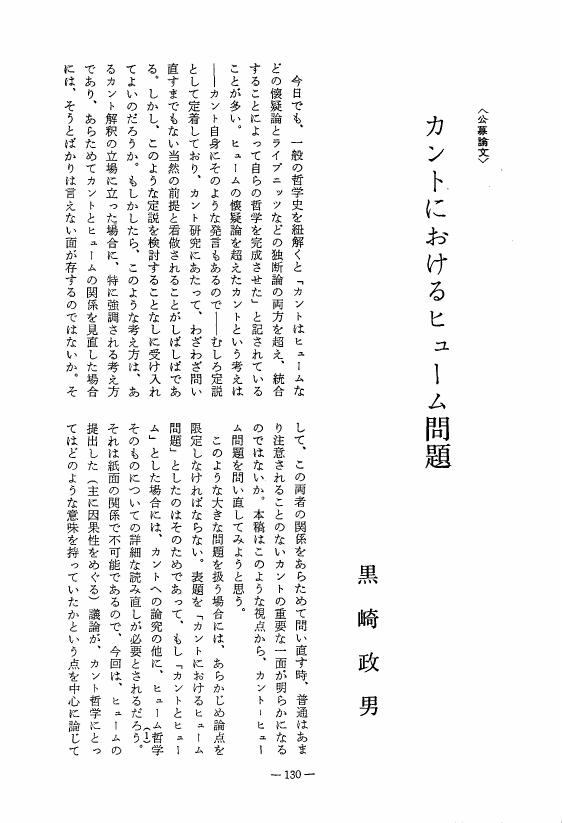9 0 0 0 IR 天下無双のヒロウソホ-キリシタン版『デ・アニマ』邦訳の発見-
- 著者
- 黒崎 政男(1954-)
- 雑誌
- 東京女子大学紀要論集 (ISSN:04934350)
- 巻号頁・発行日
- vol.61, no.1, pp.27-53, 0000
A Japanese translation of Aristotle's De Anima that thematises what kokoro is has recently been discovered. It was done through the cooperation of Jesuit missionaries and Japanese in 1595 during the Kirishitan period (Kirishitan means early Christians in Japan in the 16th to 17th century). The manuscript fascinates us, not only because it tells us that the core of Western thought was already translated three hundred years before the Meiji era in which Japan truly encountered the West, but also because it includes an additional chapter on the permanence of anima rational humanica, which is not found in the Latin original.This suggests that it was absolutely necessary [for Christians] to preach the singularity and permanence of human kokoro (Quod anima intellectiva sit immortalis et aeterna), in order to disseminate Christianity in Japan where no fundamental distinction was made between human and animal kokoro (cf. F. Xavier, letter 29/1/1552). We can here confirm the basic difference between the Western anima and the Oriental kokoro.心とはいったい何か、を主題的に論じたアリストテレスの〈De Anima〉のキリシタン時代の日本語翻訳(1595)が最近発見された。江戸時代以前に西洋の核心となる思想が日本語翻訳されていたということ自体きわめて興味深いのだが、さらに面白いのは、日本語版には、オリジナルのラテン語版底本には存在しない「人間の理性的魂(anima rational)は永遠不滅である」という書き加えの章があることである。人間と動物との 〈心〉 の間に根本的差異をみとめない日本でキリスト教をひろめるには、 人間の 〈心〉 の特異性、 不滅性を教え込むことがどうしても必要だったのである。 ここに西洋と東洋のanimaと〈心〉の差異の基本的図式を確認することができる。
2 0 0 0 IR 天下無双のヒロウソホ--キリシタン版『デ・アニマ』邦訳の発見
- 著者
- 黒崎 政男
- 出版者
- 東京女子大学
- 雑誌
- 東京女子大学紀要論集 (ISSN:04934350)
- 巻号頁・発行日
- vol.61, no.1, pp.27-53, 2010-09
A Japanese translation of Aristotle's De Anima that thematises what kokoro is has recently been discovered. It was done through the cooperation of Jesuit missionaries and Japanese in 1595 during the Kirishitan period (Kirishitan means early Christians in Japan in the 16th to 17th century). The manuscript fascinates us, not only because it tells us that the core of Western thought was already translated three hundred years before the Meiji era in which Japan truly encountered the West, but also because it includes an additional chapter on the permanence of anima rational humanica, which is not found in the Latin original.This suggests that it was absolutely necessary [for Christians] to preach the singularity and permanence of human kokoro (Quod anima intellectiva sit immortalis et aeterna), in order to disseminate Christianity in Japan where no fundamental distinction was made between human and animal kokoro (cf. F. Xavier, letter 29/1/1552). We can here confirm the basic difference between the Western anima and the Oriental kokoro.心とはいったい何か、を主題的に論じたアリストテレスの〈De Anima〉のキリシタン時代の日本語翻訳(1595)が最近発見された。江戸時代以前に西洋の核心となる思想が日本語翻訳されていたということ自体きわめて興味深いのだが、さらに面白いのは、日本語版には、オリジナルのラテン語版底本には存在しない「人間の理性的魂(anima rational)は永遠不滅である」という書き加えの章があることである。人間と動物との 〈心〉 の間に根本的差異をみとめない日本でキリスト教をひろめるには、 人間の 〈心〉 の特異性、 不滅性を教え込むことがどうしても必要だったのである。 ここに西洋と東洋のanimaと〈心〉の差異の基本的図式を確認することができる。
1 0 0 0 OA いつもそこにライプニッツがいる
- 著者
- 黒崎 政男
- 出版者
- 日本ライプニッツ協会
- 雑誌
- ライプニッツ研究 (ISSN:21857288)
- 巻号頁・発行日
- vol.1, pp.153-169, 2010-12-15 (Released:2023-11-14)
1 0 0 0 OA カント「沈黙」の十年の意義 現象概念の確立過程
- 著者
- 黒崎 政男
- 出版者
- 日本哲学会
- 雑誌
- 哲学 (ISSN:03873358)
- 巻号頁・発行日
- vol.1982, no.32, pp.104-115, 1982-05-01 (Released:2009-07-23)
近世哲学、特にいわゆる大陸合理論においては、感性は下位の認識能力とされるか、あるいは誤謬の直接間接の原因と看做されるのが常であった。真理は、精神から感性的なものをとりのぞく時に初めて得られるものであり、人間は知性によってのみ「永遠真理」の領域に達することができる。ところがカントの場合には、感性は誤謬の原因とされるどころかむしろ「実在的認識の源泉」として、そもそも認識が成立するための「不可欠な契機」とされている。つまり「純粋理性批判」 (以下KdrVと略す) によれば、認識は感性と悟性が合一することによって初めて成立する、とされているのである。感性が真理獲得のために不可欠であるとするカントの哲学観はしたがって、感性的なものを排除することによって真理が獲得できるとするカント以前の哲学観と大きく異なることは明らかである。本稿の目的は、このような哲学観が、一七七〇年の「就職論文」から一七八一年KdrV成立までの、著作のほとんど存在しないいわゆる「沈黙の十年」の思索において真に確立されたということを、七一・七二年のヘルツ宛て書簡や七五年の遺稿集である博 “Der Duisburg'sche Nachlass” などの考察を通じて明らかにすることにある。もちろん七〇年論文の段階でも、カントはすでに感性的なものを十分肯定的にとらえている。すなわち、感性的認識において質料と形式の対比から、時間・空間を何かがわれわれの感官の対象となり得るための形式の「主観的条件」 (Aka. II. S.400) として、また「純粋直観」 (ibid)としてとらえ、これを扱う「純粋数学」は「非常に判明」 (II. S.394f.) で「極めて真なる認識」 (II. S. 397f.) になり得るとされている。このように、七〇年論文において主張された「時空の主観性」説は、それだけを独立してみるならば確かにKdrVの超越論的感性論の思想とほぼ同一視することもできるかもしれない。このようなことから、七〇年論文は「悟性の実在的使用」が断念されればKdrVの思想に直結すると語られることが少なくない。確かにKdrVと七〇年論文を表面的に比較するならばこのような解釈もあやまちとはいえないだろうが、しかし私には不十分な解釈であるように思われる。つまり、この両著作の間には「経験」概念あるいは「現象」概念について微妙ではあるがしかし決定的な差違が存するように思われるからである。この決定的な変革を介してのみ、今のべたような哲学観が真に確立され得たと私は考えるのである。従って、両著作の関係についてさまざまな観点からの解釈が可能であろうが、本稿では、これまでほとんど取られたことのないと思われる観点、すなわち、沈黙の十年を現象概念の確立過程ととらえ、これを感性と悟性との関係を中心に考察を加えてみたいと思う。この考察を基にして KdrV を再解釈することが本来の目的ではあるが、紙面の関係上本稿ではこの点については若干の見通しを与えるだけで満足せざるを得ない。
- 著者
- 黒崎 政男
- 出版者
- 社団法人人工知能学会
- 雑誌
- 人工知能学会誌 (ISSN:09128085)
- 巻号頁・発行日
- vol.2, no.4, pp.420-427, 1987-12-01
1 0 0 0 OA カントにおけるヒューム問題
- 著者
- 黒崎 政男
- 出版者
- 日本哲学会
- 雑誌
- 哲学 (ISSN:03873358)
- 巻号頁・発行日
- vol.1985, no.35, pp.130-140, 1985-05-01 (Released:2009-07-23)
1 0 0 0 天下無双のヒロウソホ--キリシタン版『デ・アニマ』邦訳の発見
- 著者
- 黒崎 政男
- 出版者
- 東京女子大学
- 雑誌
- 東京女子大学紀要論集 (ISSN:04934350)
- 巻号頁・発行日
- vol.61, no.1, pp.27-53, 2010-09
